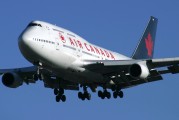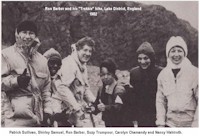|
Linda Reverchon sends this comment regarding the article in NetLetter #1383 under Ron and his "Trekkies" hike pastoral England.
Hud Connolly and I were colleagues in the PTA department (YVR Reservations) where Dorothy Grant was supervisor. By this date they had evidently already retired, but I remember them well. Ron and his "Trekkies" hike pastoral England. Wasn't Ron Barber a supervisor in the YYZ Reservations Office? I seem to remember him from the two years (1973-75) that I put in there. |
|
Vern Swerdfeger has sent us this report written by W. Roger Michelson on October 5, 2003, titled “A Landing in London”. This is the message which covered the report to Vern - As I mentioned, appended below is the story I wrote, which is called 'A Landing in London', written from a Boeing 747-400 pilot's perspective. Since that writing in 2003, an excellent video has arisen about the air traffic control around Heathrow. It is a great preamble to my story, so below is a link to it for your viewing pleasure. This video, although of poor quality, gives insight into the tight flying operations at London's Heathrow Airport, of which I wrote. Yes, Heathrow (and most of the UK) looks just like that… OLD, as you may already be aware. I have also attached an 'official' (real deal) London Heathrow Airport Ground Plan so you can see the runway arrangement, the largest of which is just over 2.4 miles in length. The runways are approximately a mile apart. This is the YouTube video for Heathrow - unfortunately of poor quality.  Also, here is a picture of an Air Canada Boeing 747-400 landing at London Heathrow at Airline-Pictures.net Also, here is a picture of an Air Canada Boeing 747-400 landing at London Heathrow at Airline-Pictures.net |
 Click the icon at left for the report called 'A Landing in London', written from a Boeing 747-400 pilot's perspective. Click the icon at left for the report called 'A Landing in London', written from a Boeing 747-400 pilot's perspective. |
|
Norman Hogwood has sent us this comment and information - A couple of things jumped out at me from 1381 today. First was Captain Len Ryman’s gift after he landed in Honolulu to end his career. According to the article he received a lei made of carnations and a cake. A bit cumbersome having a cake hanging round your neck but, after all, it’s the thought that counts and what’s a comma between friends anyway? The other item was the mention of a CP Canso operating here and there. Never heard of a Canso so I had to Google it where I found it was just a common or garden PBY Catalina. I wonder where the Canadians got that name from. It’s a lovely aircraft. The Warbirds have one here and I once had a birthday present flight in it over AKL. Wonderful! This one came from Zimbabwe and I’ve just searched its history and found that it was born in Quebec out of Vickers Canada so began life as a Canso! It was the second attempt made to get one back to NZ (the RNZAF had a substantial fleet of them during WW2) the first one having failed mid-Pacific where the crew were obliged to set it down and take to their life raft and watch it sink due to having an unfixable mechanical problem. The USAF in Hawaii answered their distress call and sent a Hercules with supplies to them. They were picked up by a huge container ship and taken to SFO. Anyway, I now know what a Canso is and that we have one here. Cheers, Norm Norman sent this additional information – Re my story about the ditching of the Catalina. I’ve just re-read the book “Catalina Dreaming” written by the guy who had the idea of getting one back to NZ. A small correction – it was the US Coast Guard in Hawaii that came to their aid. He was a crew member (and life-boat member) and had to watch his dream sink! I also found another version of the incident on Google under the heading, “A private history of the last flight of Catalina 5404J”. About a 10-minute read and worth a look. Written by an American crew member. Interestingly, he says that the co-pilot at the controls during the ditching, another American, did his nut and blamed everyone, especially the Kiwis, for their predicament. The skipper was a then current TWA B-727 captain. The delivery from Zimbabwe went without a hitch. Norm. Note: Sadly, this will be the last communication we receive from Norman as he passed away shortly after he sent the above notices. See his obituary here. |
|
In NetLetter #1350 we ran an article on the Bristol Freighter, Keith Rhodes sent this comment - Re: the Bristol Freighters. They were commonly referred to as Bristol Frighteners. TCA Engineering and Maintenance totally rewired all of them before they went into service to eliminate a known type of wiring joint used by Bristol - ball and socket, I believe. |
|
S. Brenner offers these further comments on Airtransit I have always enjoyed reading the Netletter: keep up the good work. When I read Keith Rhodes' article on the A/C advisory team who visited the DHC plant to see and advise on the equipment required to operate the DHC-6 Twin Otter aircraft proposed for the Air Transit service, I noticed that a couple of locations visited are incorrect. First the DHC plant was at Downsview (YZD) now in the City of Toronto and still is and not Malton (YYZ). After the briefing, the A/C guests were flown in a Twin Otter from Downsview to Malton (Toronto). It is not possbile to fly from the airport at Malton to the airport at Toronto as they are one and the same. There are also typos as the aircraft was a DHC-6 and not a DH-6 (many years passed in between these types). I was fortunate to travel the Air Transit service from Ottawa to Montreal and back on the next to last flight of that trial service. A truly great experience. |

